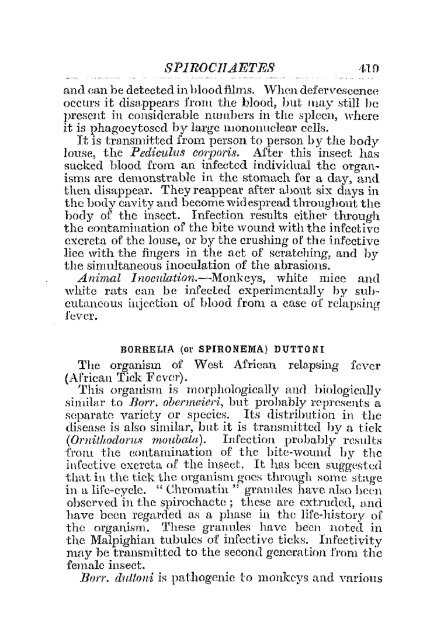AGf~ICULTURAL RESEARCH, PUSA.
AGf~ICULTURAL RESEARCH, PUSA.
AGf~ICULTURAL RESEARCH, PUSA.
Create successful ePaper yourself
Turn your PDF publications into a flip-book with our unique Google optimized e-Paper software.
SPIROCIIAETE8<br />
and nan be detected in hlood films. )VlWll defelYCSCencc<br />
OCCUl's it disappears from the blood, but Illay still be<br />
prescnt ill considerable numher:> in the spleen, where<br />
it is phagocytosed by large lllOllolluclear cells.<br />
It is transmitted from person to person by the body<br />
louse, the Pediculus corporis. After this insect has<br />
sucked blood from an infected individual the organ·<br />
isms are demonstrable in the stomach for a day, anci<br />
then disappear. They reappeal' aftcr ahout six days in<br />
the LOlly mi.vity and become 'widespread throughout the<br />
body of the insect. Infection results either through<br />
the contamination of the bite wound with the infective<br />
excreta of the louse, or by the crushing of the infective<br />
lice with the fingers in the act of scratching, and by<br />
the simultaneous inoculation of' the abrasions.<br />
Animal Inoclllation.-Monkeys, white mice and<br />
white rats can be infected experimentally hy subcutaneous<br />
iujcetion of blood from a case of relapsing<br />
1'evcr.<br />
BORRELIA (or SPIRON"EMA) DUTTONI<br />
The organism of West African relapsing fever<br />
(African Tick Fever).<br />
This organism is morphologically and biologically<br />
similar to Burr. obcrmeieJ'i, but pl'ohably represents a<br />
separate variety 01' species. Its distribution ill the<br />
disease is also similar, hnt it is transmitted by a tiek<br />
(OruitllOdol'U8 'nwilbaia). Infection probably results<br />
from the eontamiuation of the hite-wound by the<br />
infective excreta of the insect. It has been suggestc(l<br />
that in the tiek the urganism goes thl'ongh somc stnge<br />
in a life-cycle. "Chromatin" grallllies have also been<br />
observed in the spirochaete; these are extrudell, Hnd<br />
have becn l'egm'ded as a phase in the: life-}listory of<br />
the organism. l j<br />
hese granules ha vo becn noted in<br />
the Malpighian tubules of infee:tive ticks. Infectivity<br />
may he transmitted to the second generation from the<br />
femalc insect,<br />
Barr. duttoni is pathogenic to monkeys and various

















